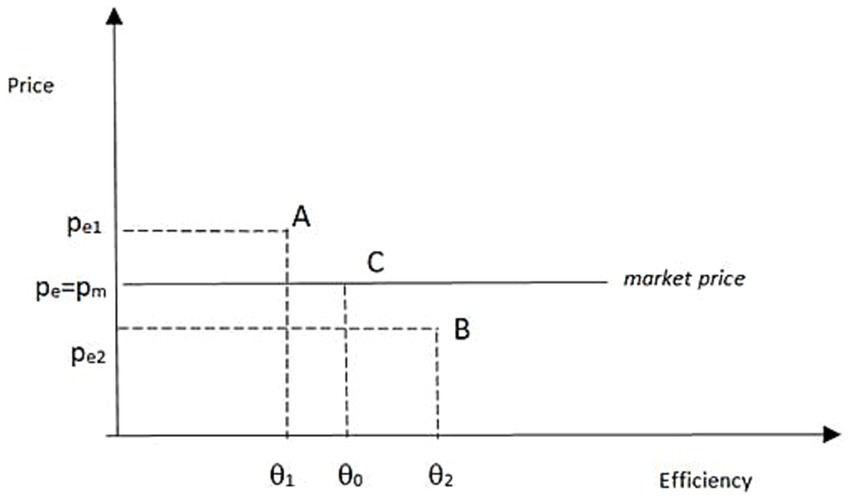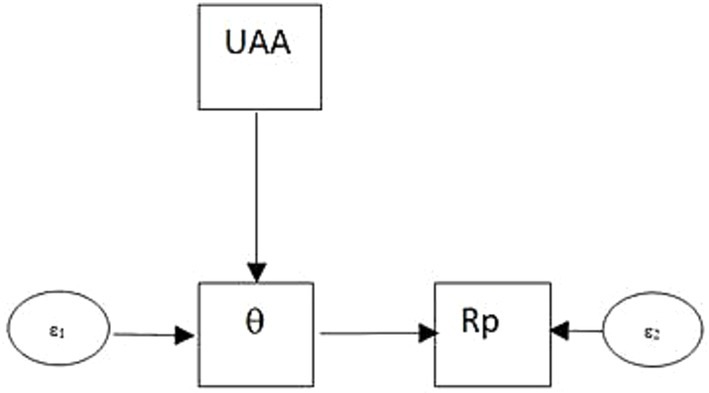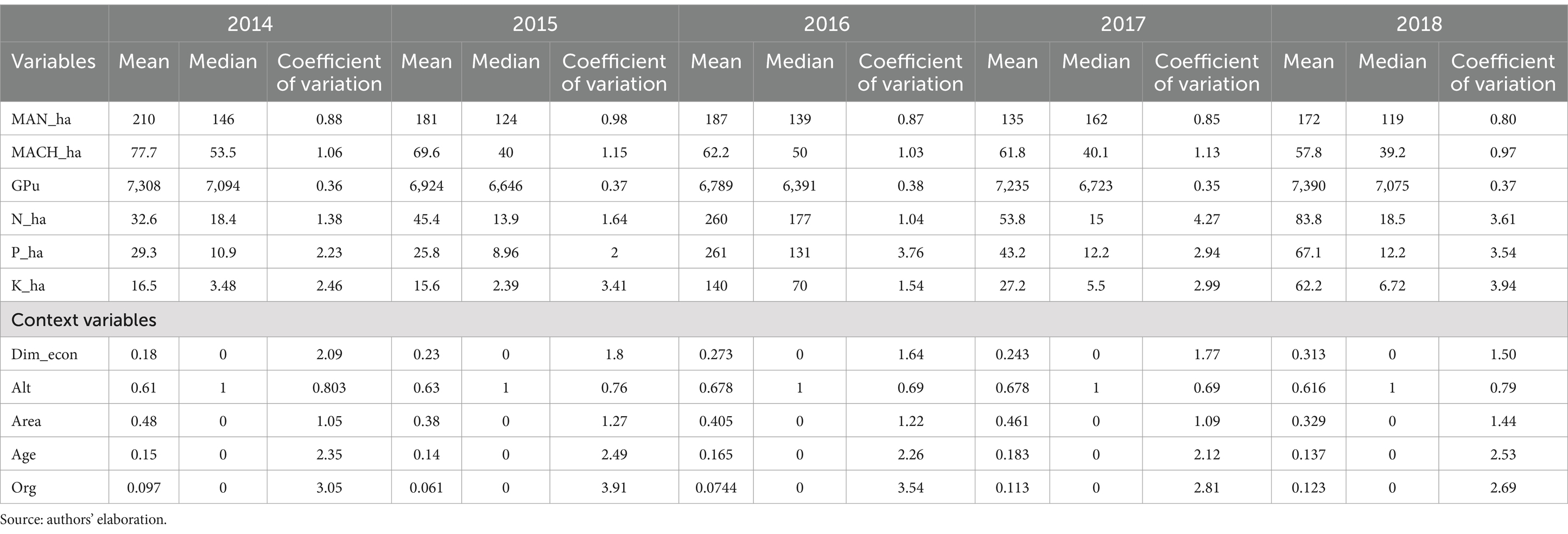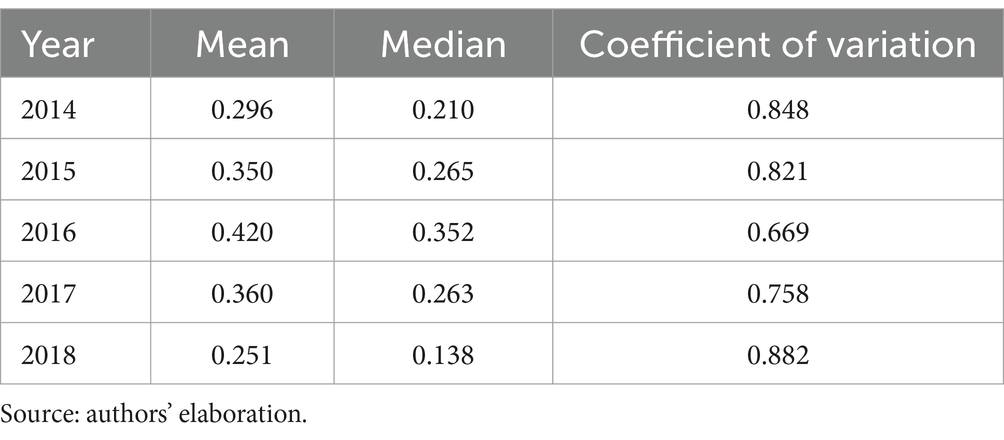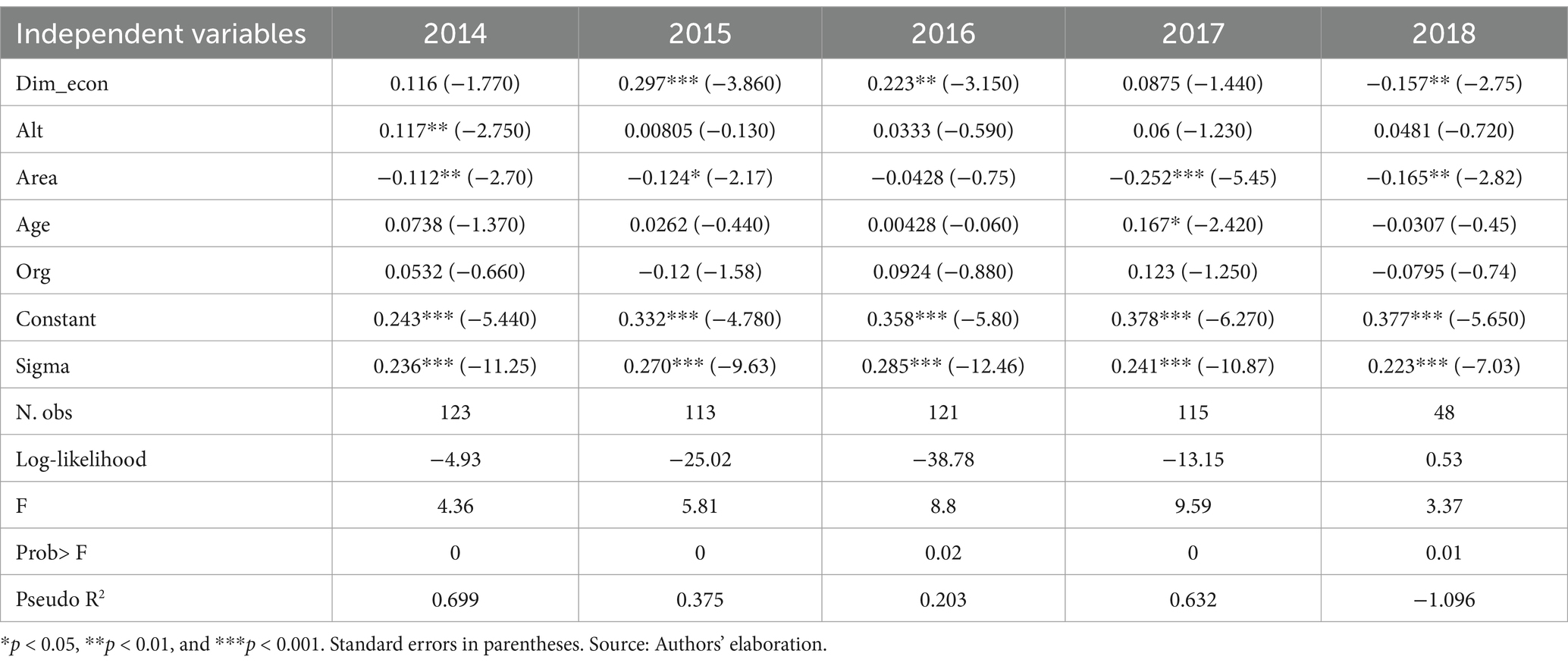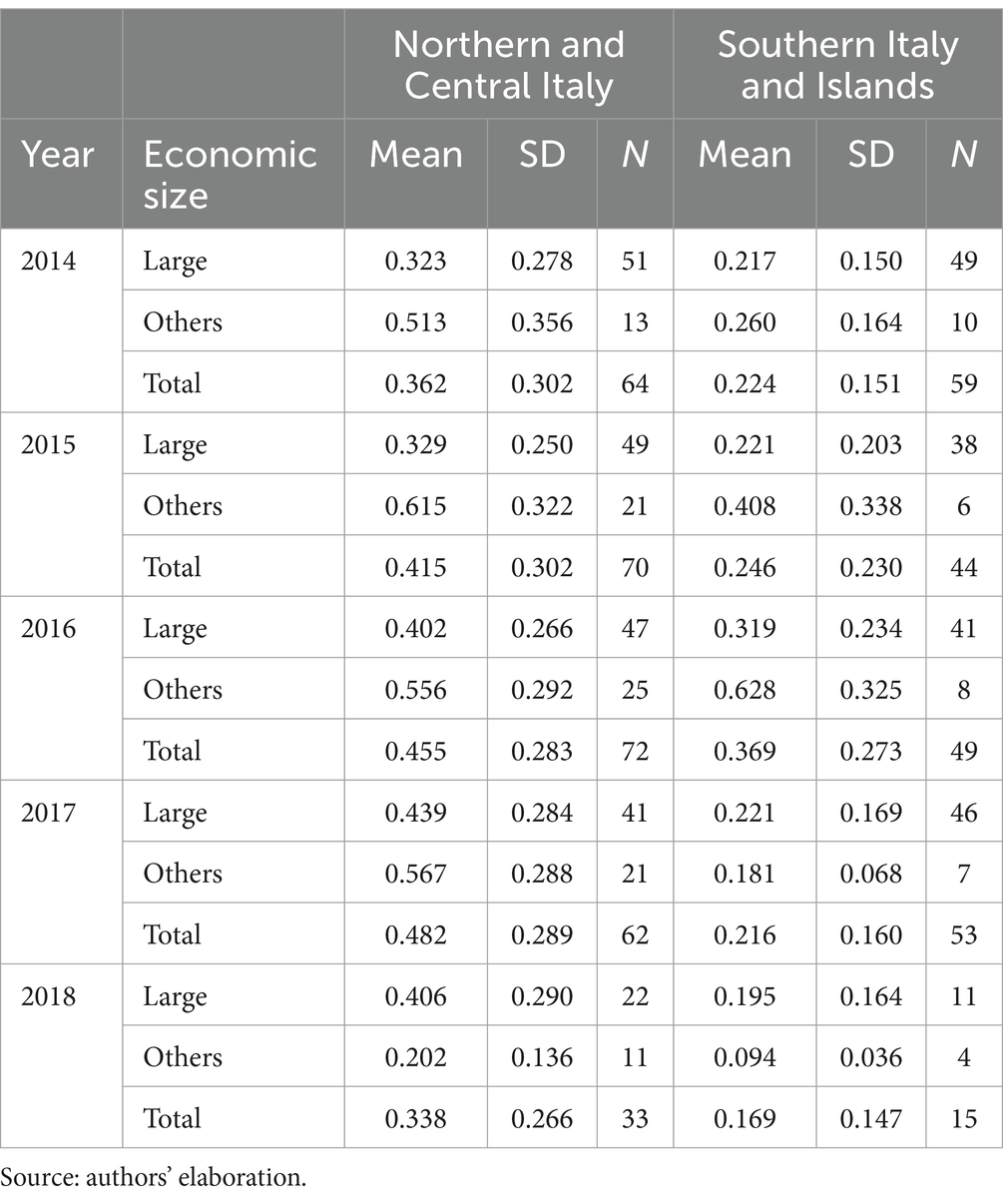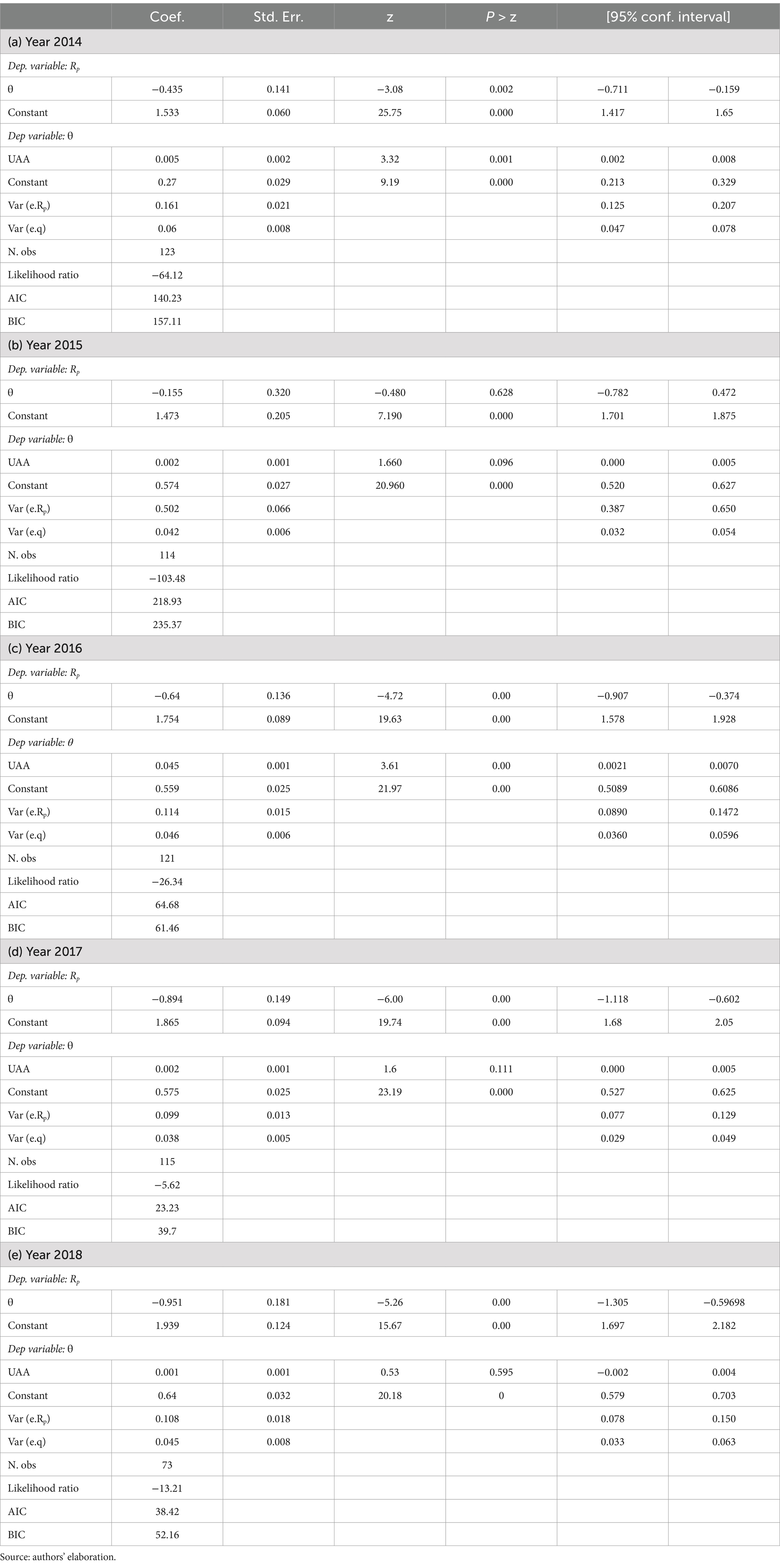- 1Department of Agricultural, Food and Environmental Sciences of the University of Perugia, Perugia, Italy
- 2Council for Agricultural Research and Agricultural Economics Analysis (CREA-PB)—Agricultural Policies and Bioeconomy, Perugia, Italy
It is usually believed that the position of farmers along the agro-food supply chains is weak, and this circumstance leads farms to achieve modest prices for their products and, in turn, capture only a small share of the added value. Such a situation substantially limits farms’ efforts to adequately remunerate the resources employed, including contract and hired labor. This article argues that, while the unfavorable position of farms is a valid concern, it is also crucial to consider how the efficient use of resources employed in agriculture impacts their remuneration, by means of price mechanisms. An empirical analysis conducted on a FADN sample of farms producing processing tomatoes over the years 2014–2018 reveals that the product price which allows for adequate compensation of hired agricultural labor decreases with increasing efficiency. At the same time, all other things being equal, for price levels above the theoretical one, the profit of the farms increases and the possibility for fairer wages as well.
1 Introduction
There is a consensus among scholars regarding the weakness of agricultural farms compared to other actors in agro-food supply chains (Russo et al., 2023; Koppenberg, 2023; Bonanno et al., 2018; Ton et al., 2018; Hendrikse and Bijman, 2002). The price obtained by a farm for its products is a central element in determining the effective possibilities that the farm has to adequately remunerate the factors of production utilized. Recognizing this heterogeneous distribution of bargaining power is the main premise of the argument explaining the unfavorable condition of farms in food chain value distribution. Usually, the low share of added value attributed to farms, compared to those achieved by other actors in the supply chain, is motivated by their weak capacity to impose their conditions in the agricultural exchange process. Accordingly, political intervention in markets, collective action by farmers, and the adoption of bilateral contractual instruments are often advocated to cope with this issue, to contrast the loss of farmers’ welfare, and to promote the development of the sector and fair remuneration of resources (Di Marcantonio et al., 2020; Requena-i-Mora and Barbeta-Viñas, 2024; Bellemare and Bloem, 2018; Bijman and Iliopoulos, 2014).
Farms’ weakness in food chains often leads them to receive low or modest prices for the products they sell. However, farmers’ legitimate claim concerning the necessity of receiving larger prices from the processing or distribution stage is based on the implicit assumption that farms’ production processes are efficient. Therefore, efficient processes can provide the benchmark measure for the market price even if this topic has not been systematically investigated in the literature (Antonioli et al., 2023). The objective of this article is to contribute to filling this gap by investigating the pattern of the relationship between the level of production process efficiency and the price of agricultural products.
This article aims to contribute to the analysis of the relationship between the added value distribution among the food chain agents and the capability of the farm to adequately remunerate the factors of production utilized.
The analytical perspective of this study considers the organization of the relevant transactions in food chains and the efficiency of the agricultural production process. Specific attention is paid to the relationship between the price of a given agricultural product, the efficiency of the production process, and the consequent ability to adequately remunerate external resources acquired by the farm. Among them, the focus of the empirical analysis is on agricultural labor. Although mechanization has progressively reduced the need for labor in farming, the workforce is still relevant in certain sectors or operations, such as fruits and vegetables harvesting, and such a critical role in the COVID-19 pandemic and its related restrictions (Christiaensen et al., 2021; Latham-Sprinkle et al., 2019; Górny and Kaczmarczyk, 2018; Richards and Rutledge, 2023; Rye and Scott, 2018).
The article is organized as follows. Section 2 presents the conceptual framework of the study. In this study, particular attention is given to placing the relationship between product prices and wages for non-family labor within the context of the increasing complexity of relationships characterizing the agro-industrial system. Section 3 presents the method of empirical investigation: The analysis focuses on the economic results of the processing tomato production process and directly relates the chosen reference wage to the product price, with the intent to identify the product price that ensures an adequate wage. The results of the empirical analysis are then presented and discussed in Section 4 before final remarks and implications for policymakers and researchers are provided.
2 Conceptual framework
The farm exchanges its products by organizing transactions with downstream companies, and, at the same time, it acquires external resources from upstream agents. Namely, the farm maximizes its profit by producing and selling the quantity for which the equality pm = Cm holds, where pm is the price of the product and Cm is its marginal cost. The price pm is determined by organizing the transaction T1. The marginal cost depends upon the technical efficiency of the production process and the prices of the external resources1. The owners of these resources require adequate prices to make their resources available to the farm. It is then reasonable to posit the question: what should be the price of the product that ensures the farm to pay the required prices for the external resources? To answer this question entails considering the market of the product, the market of the resources, and the technical efficiency of the production process. In the following, among the external resources we concentrate on agricultural labor because of (a) the importance of human labor in many critical farm productive operations; (b) the market is usually regulated by collective bargaining and contracts which set the wage but, at the same time, the large availability of workers—also in fragile legal condition (Górny and Kaczmarczyk, 2018)—and the presence of illegal organizations make possible for a farm to lower the wage also by means of illegal practices (Rye and Slettebak, 2020; Salvia, 2020; Angiuoni, 2017; Perrotta, 2014).
The exchange of the agricultural products is undertaken by organizing the transaction T1 (see Figure 1) which connects the farms and the downstream (processing, distribution) company. In T1, the agents seek to get the governance structure right and organize the exchange by economizing on the transaction costs (Williamson, 2000). A huge literature showed how farmers seek to improve the organization of the exchange to achieve a more efficient organization and counterbalance the power of the downstream company (Bonanno et al., 2018; Bijman and Iliopoulos, 2014; Fałkowski and Chlebicka, 2021).
It is reasonable that for different levels of production process efficiency, a farm will seek to achieve different prices of the product to repay the prices in turn required by the owners of the external resources. The transaction T2 concerns usually the recruitment of agricultural workers who provide external labor to the farm.
It follows that, first of all, the farm should efficiently organize transaction T1; then, it would need to efficiently allocate resources and also procure external resources, including non-family agricultural labor. We observe that pm—that is the market price—can ensure adequate remuneration of external resources provided that an adequate level of efficiency is achieved in the farm’s production activities. This means that in production activities, a farm needs to get the marginal condition right (Williamson, 2000, pp. 597). That is, for a given level of production process efficiency θ1, let pe the theoretical market price in T1 which allows a farm to pay an adequate and fair wage2 to the agricultural workers: The larger the efficiency of the farm production process, the smaller, ceteris paribus, should be pe. The theoretical relationship between the efficiency θ and the price pe is shown in Figure 2.
If an efficient governance structure in T1 allows the exchange at the market price pm, at the level of production efficiency θ0, the theoretical price is pe = pm: At this market price, the farm can pay a fair wage for hired labor. If the level of production efficiency is θ1, the price pm would not allow the farm to pay pe. The farm should receive a market price equal to pe1 to adequately remunerate its resources, but a price higher than pm could not be achieved. Therefore, a trade-off may exist between the farm profit and the wage: The farm may pay a fair wage only reducing its profit. Finally, if the level of production efficiency is larger than θ0, say θ2, the farm can pay a fair wage (since, actually, pm > pe2) and gain an increasing profit as well.
Based on the previous analysis, we submit that the level of efficiency of the farm production process causes the ratio Rp = pe/pm because the larger (smaller) the production process efficiency, the larger (smaller) the capacity of the farm to pay a fair wage by the market price pm and the closer (more distant) the theoretical price pe is to pm. This fact has two implications which can be expressed by the following two propositions:
Proposition 1: variations in the efficiency of the farm production process θ cause the ratio Rp between the theoretical price pe and the actual market price pm to vary.
Proposition 2: if the efficiency of the production process increases (decreases), then the ratio Rp between the theoretical price pe and the actual market price pm decreases (increases).
An empirical test of both propositions is carried out henceforth by examining the relevant case study of the Italian processing tomato sector.
3 Materials and methods of the empirical analysis
The steps of our empirical analysis are the following:
a. To gather data concerning production costs and prices for a given agricultural production process,
b. To determine the price pe,
c. To determine the production process efficiency θ,
d. To investigate the pattern between the ratio pe/pm and θ.
3.1 Dataset
The Italian processing tomato sector was chosen as a case study due to the large employment of the company and non-company labor. For this purpose, useful data for the analysis were extracted and processed from the FADN dataset for 5 years (2014–2018).
The Farm Accountancy Data Network (FADN) is an annual sample survey established by the European Economic Community Commission in 1965 with Regulation EC 79/56 and updated with Reg. EC 1217/2009 and subsequent amendments.
The FADN survey does not represent the entire universe of farms surveyed in a given territory but only those that, due to their economic size, can be considered professional and market-oriented.
Currently, the Italian FADN is based on a reasoned sample of approximately 11,000 farms, structured to represent the different production and size types present in the national territory. The methodology adopted aims to provide representative data on three dimensions: administrative regions, farms’ economic size, and their technical-economic orientation (i.e., type of farming).
3.2 Determining the price pe
To determine the theoretical price pe that would ensure the farm to pay fair wages for non-family labor, Equation 1 can be used:
where:
CV’ = total variable costs excluding total wages paid for non-family labor,
weL = total wages paid for non-family labor L,
CF = total fixed costs,
T = extra profit,
Q = quantity produced.
and
where:
cv = CV’/Q, variable cost per product unit (except than total wages paid for non-family labor),
cf = CF/Q, fixed cost per product unit,
se = weL/Q, fair wage per product unit,
π = T/Q, extra profit per product unit.
The fact that a fair wage we is guaranteed by the price pe as given in Equation 2 is based on the assumption that all other elements in Equation 2, except for se, are given. This implies that all the owners of the external resources are deemed able to get paid at the right market prices for what they provide to farmers. In other words, the price indicated by Equation 2 represents a price level that would adequately compensate for non-family labor. In the discussion of the results, implications related to the institutional context of this definition will be considered as well.
3.3 Estimation of the production efficiency θ
The Data Envelopment Analysis (DEA) approach was followed to estimate production efficiency. DEA consists of a mathematical programming model that, using observed data (collected from FADN in our case), provides empirical estimates of input–output relationships and efficiency (Charnes et al., 1978). A unit is considered efficient if there are no other units in the examined sample capable of producing the same output level with fewer resources (or producing a higher output level with the same number of resources). Therefore, the DEA is not concerned with absolute efficiency levels but relative levels.
Since efficiency also depends on uncertain operating conditions and practices (related to the environment, technological equipment, and managerial approaches), we indicate them as “context variables” (Fried et al., 1999; Johnson and Kuosmanen, 2012), and the analysis is carried out in two stages henceforth described. In doing so, it is possible to explore the possibilities of identifying managerial strategies aimed at improving efficiency or regulatory interventions (Johnson and Kuosmanen, 2012).
Therefore, in the first stage, the efficiency level was determined for each farm. Then, in the second stage, the effect of context variables on the previously estimated efficiency level was analyzed as well.
To this purpose, since the efficiency index θ assumes values within the range between 0 and 1, the analysis of the effect of instrumental variables must be conducted with specific models. Accordingly, Tobit models were adopted in this study, with the following specification:
where the parameters β₀ and βi measure the impact of the contextual variables on efficiency, and ε represents the error in the estimates (Greene, 2008).
Efficiency levels were determined using the set of relevant inputs (human and mechanical labor, fertilizers) calculated on a per-unit basis, as follows:
• MAN_ha, human labor per hectare of crop,
• MACH_ha, mechanical labor per hectare of crop,
• N_ha, level of nitrogen fertilization per hectare of crop,
• P_ha, level of phosphorus fertilization per hectare of crop,
• K_ha, level of potassium fertilization per hectare of crop.
The output was also considered on a per-unit basis (GPu: gross production per hectare, quantity*price). According to this approach, the context variables considered were as follows:
• Dim_econ, reporting farm economic size according to the FADN classification (large, medium-large, and small),
• Alt, indicating the average altitude of farmland (plain or hill/mountain),
• Area, which identifies the geographic area where the farm is located (1, if in the South; 0, if elsewhere),
• Age, revealing the presence of young entrepreneurs,
• Org, indicating organic farming.
Table 1 shows the descriptive statistics of the variables used.
3.4 Testing the propositions
Proposition 1 relates to a causal relationship between θ and Rp, with further variables accounting for the different capabilities of farms to organize efficient production processes. The simplest way to describe this relationship is to consider the nexus from θ to Rp and a nexus from the utilized agricultural area (UAA) toward θ. The latter accounts for the fact that land is the main productive resource in agriculture, and it tends to constrain the capability of the farm to reach an adequate level of efficiency (De Benedictis, 2009; Reinhard et al., 1999). Figure 3 shows the diagram illustrating this causal relationship.
Proposition 2 is then tested just by descriptive graphics, observing the causal pathways between θ and Rp, for increasing (decreasing) levels of θ.
4 Empirical analysis
4.1 The processing tomato sector in Italy
The 10 largest producing regions or countries account for approximately 80% of the global production of processing tomatoes. California (10.1 million tons), Italy (4.8 million tons), and China (4.5 million tons) are the three main producers worldwide. It follows that the Italian processing tomato sector is very developed as the total amount of processed tomato was approximately 37 million tons in 2022 (World Processing Tomato Council data). The processing tomato supply chain is organized into two large interbranch organizations (IBOs). The “Nord Italia” IBO manages 36,000 hectares of processing tomatoes, involving approximately 2,000 agricultural producers (grouped into 13 producer organizations, or POs) and 25 processing plants (belonging to 20 different companies). This cultivation leads to the processing of approximately 2.5 million tons of tomatoes into tomato concentrates, pulps, and purees. The “Bacino Centro Sud Italia” IBO involves 22 POs (managing approximately 28,000 hectares of tomato crops) and 51 processing companies (working with 2.3 million tons of tomato, corresponding to approximately 90% of the production obtained in Southern and Central Italy).
4.2 The analytical approach
The analyses were carried out by selecting farms sampled in the Italia FADN dataset over the period 2014–2018. This approach yields five samples (one per year) of different sizes which were analyzed separately.
First, all observations with anomalous data that could bias the result were eliminated, as follows:
• Farms with no production for the crop under consideration, since they did not achieve marketable production due, for instance, to phytosanitary issues or adverse weather conditions.
• Farms with yields excessively out of range, presumably due to phytosanitary issues and adverse weather conditions.
• Farms with small crop areas, since the incidence of fixed costs would have an excessive impact on the price per unit calculation.
After eliminating all these anomalous observations, the box plot diagram was applied to graphically represent and describe the sample distribution through dispersion and position indices. This procedure allowed us to remove outliers as well.
To calculate the value pe (a price that guarantees a fair salary), some values were directly taken from the FADN dataset into account, whereas others were calculated on purpose. Specifically, while crop variable costs come from the dataset, crop fixed costs were calculated using the company fixed costs from the database and subtracting labor costs (temporary and permanent), social charges, and salary.
The value pe was therefore obtained by first adding all the costs currently attributed to the crop (variable and fixed costs) to the profit, then dividing this value by the quantity of production. Such a procedure gave the theoretical price pe able to guarantee a fair wage, which was assumed to be 12 €/h for the simulation (Guidi and Berti, 2023).
5 Results
5.1 The processing tomato crop: the pe distribution
A summary of indicators related to processed tomato cultivation in Italy for the period under observation is reported for all districts, regions, altitude zones, and farm sizes (Table 2). All indicators have a very low variability, as reported by the coefficient of variation. As seen, the price that would ensure a fair wage for temporary labor amounts to an average of 116 €/ton (with a median value of 107 €/ton). The difference between the fair price and the observed price is indeed modest (on average 27 €/ton, with a median value of 20 €/ton).
This information is of sure interest for analysis. First, because it indicates the existence of a realistic negotiation margin for farms, producer organizations, and trade unions: If half of the observed farms received 20 €/ton more, they would have the basis to guarantee the remuneration of all the production factors used, earn a profit comparable to the current one, and pay a fair wage of 12 €/h (that is four times what is paid to irregular labor, employed under severely exploitative conditions in many areas of Italy).
The second consideration concerns the potential efficiency gains that can be achieved, a fact suggested by the great variability of the results.
5.2 Efficiency analysis
Levels of the efficiency index calculated at the unitary level of the production process are illustrated in Table 3.
The minimum value among the average and median values is in 2018, while the maximum is in 2016. Variability is more pronounced in some years (2014, 2015, and 2018).
Using the Equation 3, a Tobit model was estimated for each of the years considered for the efficiency values determined at the unitary level of the production process. Table 4 summarizes the results obtained.
The variable Dim_econ (which is dichotomous and assumes the value 1 if the company is “large” and 0 in all other cases) is statistically significant and positive in the years 2015 and 2016 but negative in 2018. This result indicates that larger companies manage to achieve higher levels of efficiency, but this does not imply a systematic and wider capability. The variable Alt (which is 1 for companies located in the plain and 0 in all other cases) has a positive effect on efficiency only in 2014, while the variable is not statistically significant in the remaining years indicating a null impact on efficiency. The area variable, on the other hand, has always had a significant and negative coefficient, except for 2016. As recalled, this variable takes the value 1 for companies located in the South or Islands and 0 for all other cases. Consequently, the result indicates that companies in both Southern Italy and the Islands areas have a lower capacity to achieve efficient production processes compared to those in other areas where processing tomato is cultivated. Finally, note that the two variables Age and Org do not have statistically significant coefficients (except for Age in 2017). Summarizing, the determination of the technical efficiency of the production process conducted at the unitary level indicates that (i) technical efficiency is systematically low, (ii) large companies have a higher capacity to improve efficiency, and (iii) companies in Southern Italy and the Islands areas seem to have less capacity to improve technical efficiency.
5.3 Relationships between price ratio Rp and efficiency θ
From the perspective of economic size, it is the medium-small companies (from 25,000 to 50,000 € PS) that have the highest pe value (173.4 €/ton). Large companies, on the other hand, have a much lower pe value of 111.7 €/ton. Observing the difference between the calculated price and the recorded price, it is the small and medium-small companies that show the greatest difference, while the large ones have a delta smaller than the national average (see Table 5).
As far as the form of business management is concerned, farms directly managed with a prevalence of family members have a higher pe value compared to other management forms, equal to 135.9 €/ton. The businesses with the lowest pe value are those managed solely by family members (117.4 €/ton). The price gap between the calculated and recorded prices is similar for all five cases, although greater variability is observed for businesses directly managed with a prevalence of family members.
Table 6 summarizes the SEM models estimated.
The causal relationship from θ to Rp is proved for all five models except for the 2015 sample. The parameters estimated for θ are statistically significant and with expected signs. Proposition 1 is then verified.
Finally, graphs 1–5 illustrate the pattern of the price ratio with respect to the efficiency of the production process. A local polynomial regression has been carried out for each of the years under analysis to synthesize the pattern observed (see the line in the graphs, with a 95% confidence interval). It is easy to see that in all the years of the period considered, the larger the efficiency, the smaller the price ratio and close to 1 so that proposition 2 then is verified.
Moreover, we observe that when the market price is low, farms can achieve a normal or higher profit by improving their efficiency. Given the collectively negotiated wage, there is a minimum efficiency level (θ*, θ1, and θ2) that allows the farm to pay a fair wage. It comes out, therefore, that improving efficiency levels offers opportunities for paying a fair wage equivalent to those provided by increasing the market price.
6 Discussion
The evidence confirms the pattern conjectured for the price ratio pe/pm and the efficiency. Two cases have to be considered assuming that a given price pm is determined by the exchange. First, let us consider the case of farms that achieve only a low production process efficiency. In this case—illustrated in Figure 1 by θ < θ0—the farms seek to achieve a market price for the product larger than pm, but this is impossible if the exchange has been already organized “getting the governance structure right” (Williamson, 2000, pp. 592 ff.). Therefore, the farms will be unable to pay an adequate, fair wage and, in turn, this implies two alternative consequences: A farm may seek to remain in the sector activity if at least the fixed costs are covered or a farm may decide to reduce the wage below the due level. These two alternatives differ in terms of the institutional environment which may support one or the other alternative. The premise for the first alternative to viable is that the market for the product and labor work correctly: More precisely, we assume that inclusive institutions (Robinson and Acemoglu, 2012) allow the farmers to efficiently organize the transactions T1 and T2. In this case, a farm could expect to improve its efficiency in subsequent production and supply cycles to get and pay the right prices. The second alternative—to reduce the wage below the fair level—entails a completely different setting, characterized by extractive institutions (Robinson and Acemoglu, 2012) which allow the transfer of wealth from workers to farmers through salary cuts. In Italy, the existence of such a form of institution has been documented, assuming the form of the caporalato (gangmaster) (Perrotta, 2014; Salvia, 2020). It implements the possibility of having very low wages by illegally recruitment of workers, often migrants deprived of legal status. The diffusion of such extractive institutions which may support the existence of inefficient farms has to be carefully taken into account because they implement incentives for farmers to remain inefficient. This in turn could distort the competition process and also sustain the diffusion of inefficient business management among other farmers. It must be also pointed out that regulation intervention or collective actions aimed at increasing the price paid for the product—e.g., by increasing the bargaining power of farmers—distort the resource allocation if the efficiency is low and therefore lead the system to waste resources.
The case of large efficiency—illustrated in Figure 1 by θ > θ0—allows the farm to gain net compensation for the resources employed. In this scenario, the profit increases allowing farmers to pay a fairer price for external resources, labor included. Beyond pure technical issues, also economic factors are critically at stake. Under this view, Dupraz and Latrouffe (2015) deeply investigate the relationship among family, contract, and hired labor in the case of French agriculture, highlighting the importance of wages and monitoring costs in determining the pattern of diffusion of these different forms. Christiaensen et al. (2021, pp. 7 ff.) underlined the impact of different farm strategies and pointed out the potential benefits of migrant workers’ recruitment. Our evidence indicates that efficient management of the production process allows a farm to improve its room for maneuver in contract or hired workers’ recruitment.
7 Conclusion and policy implications
This study has proposed an original and innovative investigation of the relationship between product price and wages in the context of complex agro-industrial relations. The empirical analysis explored this relationship based on simple propositions on the level of wages. Despite some caveats, data were adequate to provide a general perspective, which can certainly be improved; our research findings carry significant implications for policymakers and researchers.
First of all, an attempt has been made to emphasize how the profound transformation of the relationships between the farm and the remaining components of the agro-industrial system has accentuated the importance of entrepreneurship, highlighting the focus on actors and activities along the supply chain, but reducing the attention paid to the underlying connections between the other factors of production (i.e., land, labor, and capital). The nexus between supply chain relations and those between factors of production needs to be reconsidered by agrarian economic analysis and policymakers to identify its boundaries and strengths within the framework of current agro-industrial relations. In the redefinition of sectoral regulation, initiated with the approval of the Reg.EU 1308/2013 on the Common Market Organization, the ability of the farm to adequately remunerate the factors of agricultural production must be recognized as a central element of agricultural entrepreneurship. The definition of efficient relations with downstream sectors—mediated by contracts or by the planning of POs or other forms of organization—should take on the responsibility of including in agro-industrial agreements an adequate relationship between price and remuneration of agricultural production factors. In this perspective, the usefulness of statistical information on actual price and wage levels grows, as does the importance of transparency and the circulation of information. In this regard, reliable and updated information on actual prices and wages is a relevant asset for all actors in the supply chain, including consumers. It, therefore, seems reasonable to consider the hypothesis of defining mechanisms for the transmission of this information, such as to ensure its circulation for all the involved actors and their stakeholders.
A second reflection concerns the possibilities that agro-industrial and wage bargaining may find elements of strategic convergence between the growth of the contractual capacity of the agro-industrial farms along the supply chain and their capacity to adequately remunerate the productive resources deployed. The case of processing tomatoes seems to signal that such a possibility is perhaps realistic. On the other hand, the study also proposes more controversial evidence that seems rather to suggest that the efficiency gains of farms may perhaps represent one of the first objectives for improving the position of farms and labor.
Data availability statement
The raw data supporting the conclusions of this article will be made available by the authors, without undue reservation.
Author contributions
AM: Writing – review & editing, Writing – original draft, Validation, Supervision, Methodology, Funding acquisition, Conceptualization. SC: Writing – review & editing, Supervision, Methodology, Conceptualization. NG: Writing – review & editing, Formal analysis, Data curation. LT: Writing – original draft, Data curation. GM: Writing – original draft, Supervision, Methodology, Funding acquisition, Formal analysis, Conceptualization.
Funding
The author(s) declare financial support was received for the research, authorship, and/or publication of this article. This work was supported by: (a) research project Su.Pre.ME. (2020–2022) financed by the AMIF – Emergency Funds (AP2019) of the European Commission – DG Migration and Home Affairs and supported by the Italian Regione Campania, Regione Puglia (coordinator), Regione Basilicata, Regione Calabria and Regione Sicilia with the technical assistance of the Consorzio Nova and the Osservatorio Placido Rizzotto-Flai Cgil and (b) the Italian Ministry of University and Research under the research program “PON Ricerca e Innovazione”.
Conflict of interest
The authors declare that the research was conducted in the absence of any commercial or financial relationships that could be construed as a potential conflict of interest.
The author(s) declared that they were an editorial board member of Frontiers, at the time of submission. This had no impact on the peer review process and the final decision.
Publisher’s note
All claims expressed in this article are solely those of the authors and do not necessarily represent those of their affiliated organizations, or those of the publisher, the editors and the reviewers. Any product that may be evaluated in this article, or claim that may be made by its manufacturer, is not guaranteed or endorsed by the publisher.
Footnotes
1. ^Farmers usually own several resources: land, equipment, household labour, and so on. The remuneration of each of these resources derives from the net gain of the production and selling processes as farmers have primarily to pay the owners of the external resources to make them available for the farm. For the sake of simplicity, in the text, we simply label all the residual gains of the farm as “profit” without taking into account the distribution of these gains among the different resources and the entrepreneurship effort. This choice does not limit the analysis as its focus is on the potential tensions between product and external resource prices.
2. ^Fair wage refers to company practices that lead to sustainable wage developments, which is a wage never lowers the living wage, but never lower because the living wage is only one of the elements of a fair wage. To be able to pay fair wages, several conditions have to be met, among which is that the living wage must be known (Bronkhorst, 2020).
References
Angiuoni, S. (2017). A comparative study of informal labour intermediation and workforce reproduction practices in Italy and the UK. A research in progress. Cartografie sociali. Rivista semestrale di sociologia e scienze umane, 2.
Antonioli, F., Severini, S., and Vigani, M. (2023). Visa for competitiveness: foreign workforce and Italian dairy farms’ performance. Eur. Rev. Agric. Econ. 50, 115–150. doi: 10.1093/erae/jbab045
Bellemare, M. F., and Bloem, J. R. (2018). Does contract farming improve welfare? A review. World Dev. 112, 259–271. doi: 10.1016/j.worlddev.2018.08.018
Bijman, J., and Iliopoulos, C. (2014). Farmers ‘cooperatives in the EU: policies, strategies, and organization. Ann. Public Cooperat. Econ. 85, 497–508. doi: 10.1111/apce.12048
Bonanno, A., Russo, C., and Menapace, L. (2018). Market power and bargaining in agrifood markets: a review of emerging topics and tools. Agribusiness 34, 6–23. doi: 10.1002/agr.21542
Bronkhorst, R. , (ed.) (2020). “Fair wages, what does it mean?” in The economics of human rights (Cham: Palgrave Macmillan).
Charnes, A., Cooper, W. W., and Rhodes, E. (1978). Measuring the efficiency of decision making units. Eur. J. Oper. Res. 2, 429–444. doi: 10.1016/0377-2217(78)90138-8
Christiaensen, L., Rutledge, Z., and Taylor, J. E. (2021). The future of work in Agri-food. Food Policy 99:101963. doi: 10.1016/j.foodpol.2020.101963
De Benedictis, M. (2009). La questione contadina: ieri e oggi. QA Rivista dell’Associazione Rossi Doria. 3, 7–44. doi: 10.3280/QU2008-003001
Di Marcantonio, F., Ciaian, P., and Fałkowski, J. (2020). Contracting and farmers’ perception of unfair trading practices in the EU dairy sector. J. Agric. Econ. 71, 877–903. doi: 10.1111/1477-9552.12388
Dupraz, P., and Latruffe, L. (2015). Trends in family labour, hired labour and contract work on French field crop farms: the role of the Common Agricultural Policy. Food Policy 51, 104–118. doi: 10.1016/j.foodpol.2015.01.003
Fałkowski, J., and Chlebicka, A. (2021). What product mix do they offer and what marketing channels do they use? Exploring agricultural producer organisations’ heterogeneity. J. Rural. Stud. 85, 1–12. doi: 10.1016/j.jrurstud.2021.05.002
Fried, H. O., Schmidt, S. S., and Yaisawarng, S. (1999). Incorporating the operating environment into a nonparametric measure of technical efficiency. J. Prod. Anal. 12, 249–267. doi: 10.1023/A:1007800306752
Górny, A., and Kaczmarczyk, P. (2018). A known but uncertain path: the role of foreign labour in polish agriculture. J. Rural. Stud. 64, 177–188. doi: 10.1016/j.jrurstud.2017.12.015
Guidi, C. F., and Berti, F. (2023). Labor exploitation in the Italian agricultural sector: the case of vulnerable migrants in Tuscany. Front. Sociol. 8:1234873. doi: 10.3389/fsoc.2023.1234873
Hendrikse, G., and Bijman, J. (2002). Ownership structure in agrifood chains: the marketing cooperative. Am. J. Agric. Econ. 84, 104–119. doi: 10.1111/1467-8276.00246
Johnson, A. L., and Kuosmanen, T. (2012). One-stage and two-stage DEA estimation of the effects of contextual variables. Eur. J. Oper. Res. 220, 559–570. doi: 10.1016/j.ejor.2012.01.023
Koppenberg, M. (2023). Markups, organic agriculture and downstream concentration at the example of European dairy farmers. Agric. Econ. 54, 161–178. doi: 10.1111/agec.12762
Latham-Sprinkle, J., David, F., Bryant, K., and Larsen, J. (2019). Migrants and their vulnerability to human trafficking, modern slavery and forced labour. Geneve: International Organization for Migrants.
Perrotta, D. (2014). Vecchi e nuovi mediatori. Storia, geografia ed etnografia del caporalato in agricoltura. Meridiana. 193–220.
Reinhard, S., Lovell, C. K., and Thijssen, G. (1999). Econometric estimation of technical and environmental efficiency: an application to Dutch dairy farms. Am. J. Agric. Econ. 81, 44–60. doi: 10.2307/1244449
Requena-i-Mora, M., and Barbeta-Viñas, M. (2024). The agrarian question in dairy farms: an analysis of dairy farms in the European Union countries. Agric. Hum. Values 41, 459–474. doi: 10.1007/s10460-023-10488-6
Richards, T. J., and Rutledge, Z. (2023). Food system labour and bargaining power. Food Policy 119:102502. doi: 10.1016/j.foodpol.2023.102502
Robinson, J. A., and Acemoglu, D. (2012). Why nations fail: The origins of power, prosperity and poverty. London: Profile.
Russo, C., Di Marcantonio, F., Cacchiarelli, L., Menapace, L., and Sorrentino, A. (2023). Unfair trading practices and countervailing power. Food Policy 119:102521. doi: 10.1016/j.foodpol.2023.102521
Rye, J. F., and Scott, S. (2018). International labour migration and food production in rural Europe: a review of the evidence. Sociol. Rural. 58, 928–952. doi: 10.1111/soru.12208
Rye, J. F., and Slettebak, M. H. (2020). The new geography of labour migration: EU11 migrants in rural Norway. J. Rural. Stud. 75, 125–131. doi: 10.1016/j.jrurstud.2020.01.014
Salvia, L. (2020). The restructuring of Italian agriculture and its impact upon capital–labour relations: labour contracting and exploitation in the fresh fruit and vegetable supply chain of the Lazio region, Central Italy. J. Agrar. Chang. 20, 98–112. doi: 10.1111/joac.12340
Ton, G., Vellema, W., Desiere, S., Weituschat, S., and D'Haese, M. (2018). Contract farming for improving smallholder incomes: what can we learn from effectiveness studies? World Dev. 104, 46–64. doi: 10.1016/j.worlddev.2017.11.015
Keywords: efficiency, price, FADN, external labor, agriculture, tomato, Italy
Citation: Marchini A, Ciliberti S, Gastaldin N, Turchetti L and Martino G (2024) Fair prices for fair wages in the agro-food chain: is farm production efficiency the missing link? Evidence from the processing tomato sector in Italy. Front. Sustain. Food Syst. 8:1487252. doi: 10.3389/fsufs.2024.1487252
Edited by:
Piermichele La Sala, University of Foggia, ItalyCopyright © 2024 Marchini, Ciliberti, Gastaldin, Turchetti and Martino. This is an open-access article distributed under the terms of the Creative Commons Attribution License (CC BY). The use, distribution or reproduction in other forums is permitted, provided the original author(s) and the copyright owner(s) are credited and that the original publication in this journal is cited, in accordance with accepted academic practice. No use, distribution or reproduction is permitted which does not comply with these terms.
*Correspondence: Stefano Ciliberti, c3RlZmFuby5jaWxpYmVydGlAdW5pcGcuaXQ=
 Andrea Marchini
Andrea Marchini Stefano Ciliberti
Stefano Ciliberti Nadia Gastaldin2
Nadia Gastaldin2